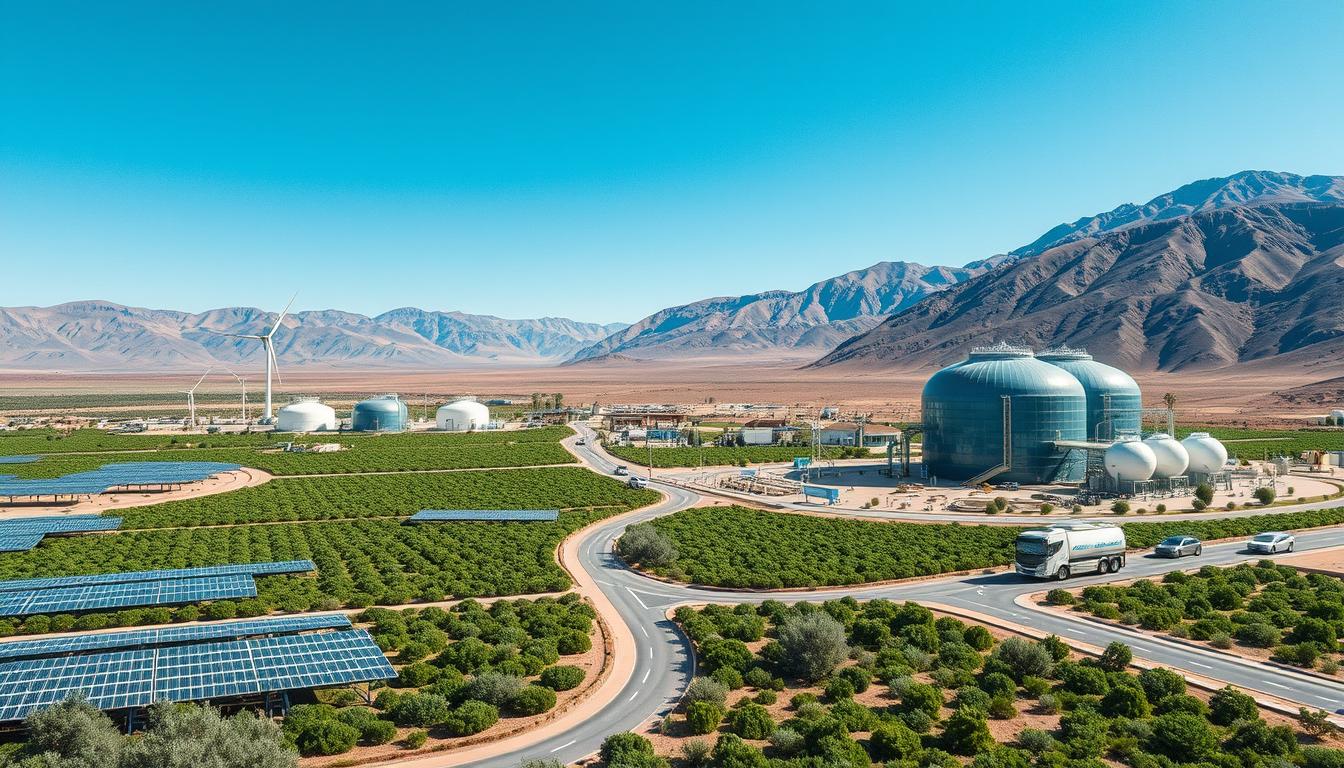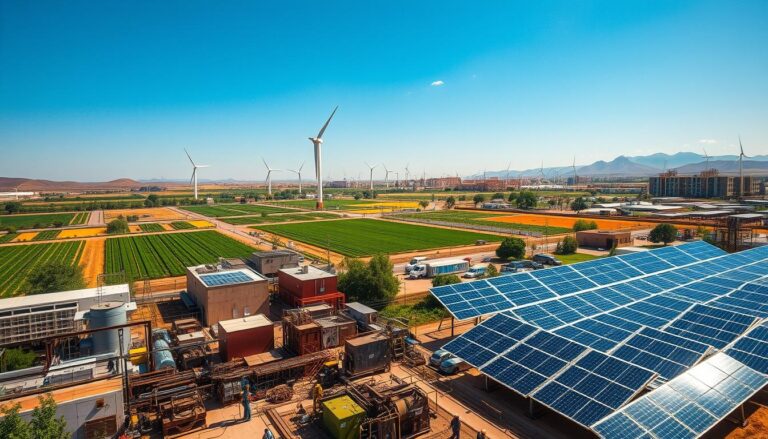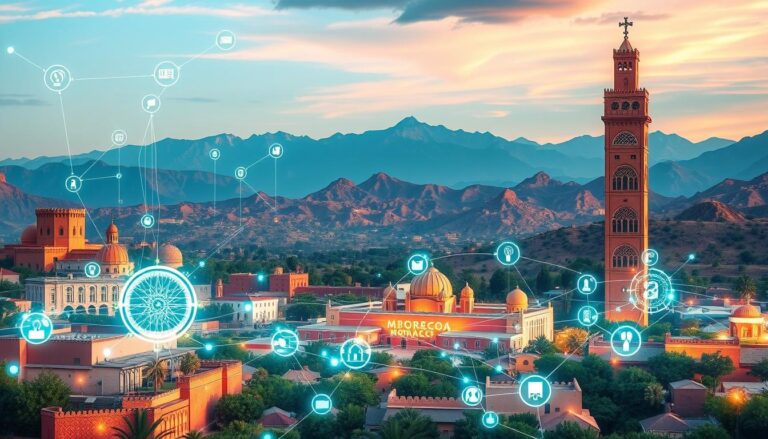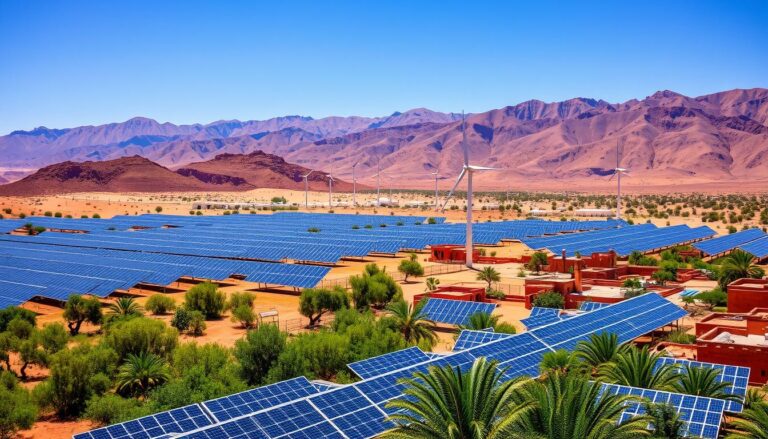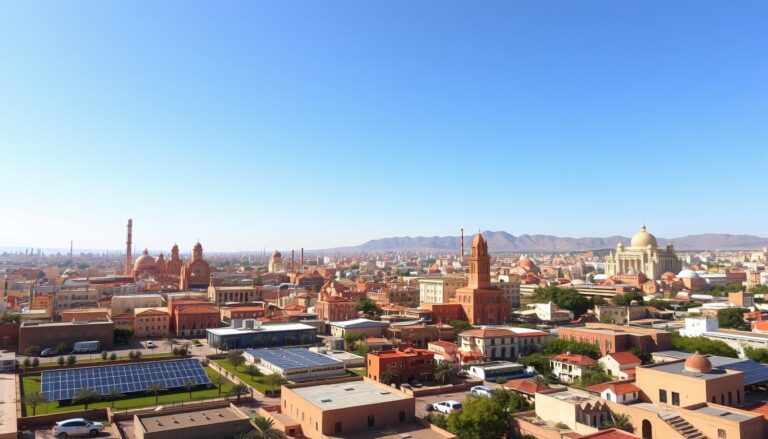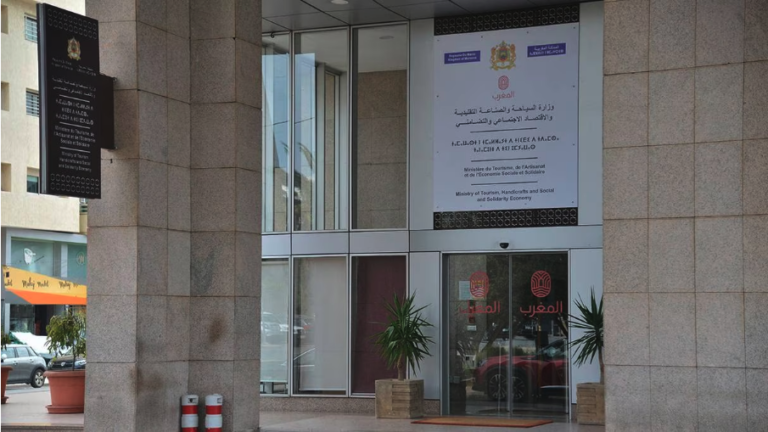Can Morocco become the center of the global hydrogen economy?
Morocco is known for its big energy plans. It’s working hard to build a strong hydrogen system. The goal is to use up to 30 TWh of green hydrogen by 2030. This will help Morocco grab a big share of the global green hydrogen market.
The Moroccan Ministry of Energy is leading this effort. They use the country’s lots of renewable energy and good location. They want to create a big hydrogen market, both locally and for exports.
Total Energies has put in €9.4 billion, and Germany has pledged €300 million. This support shows Morocco’s clean energy plans are serious. They aim to use 13.9 TWh to 30.1 TWh of hydrogen by 2030. By 2050, they hope to use as much as 307.1 TWh.
Morocco wants to be a key player in green hydrogen in Africa. This plan will create lots of jobs and help fight climate change.
Introduction to Hydrogen Infrastructure in Morocco
Morocco is working hard to have a sustainable future. It’s using its lots of renewable energy to change its energy sector. The country wants to be a big player in the hydrogen market, especially in Europe.
It’s planning to build a lot of infrastructure. This includes land, water management, and bigger ports. This is all part of its green hydrogen vision.
Overview of the Green Hydrogen Vision
The government has set aside about one million hectares for green hydrogen. It’s starting with 300,000 hectares, divided into smaller plots. They’re studying how to make ports better for hydrogen trade.
They’re also focusing on water management. This is because green hydrogen needs a lot of water. They plan to expand desalination to meet this need.
Importance of Hydrogen in Energy Transition
Morocco wants 52% of its electricity to come from renewables by 2030. They’re working on the grid to support hydrogen production. They also want to attract more private investment in renewable energy.
The goal is to use 30 TWh of green hydrogen by 2030. By 2050, they aim for 307 TWh. This shows Morocco’s commitment to a green economy and the global hydrogen market.
They’re building strong infrastructure and working with other countries. They’re also training experts through universities and research. This is all part of their green hydrogen vision.
Morocco’s Renewable Energy Landscape
Morocco is leading the way in solar and wind energy projects. The country has made big steps in using renewable energy. This is shown in projects like the Noor Ouarzazate Solar Complex and the Tarfaya Wind Farm.
Existing Solar and Wind Projects
The Noor Ouarzazate Solar Complex is one of the biggest solar projects worldwide. It shows Morocco’s commitment to solar energy. The goal is to have 52% of energy from renewables by 2030.
The Tarfaya Wind Farm is another key project. It shows Morocco’s focus on wind and solar energy. These projects show Morocco’s effort to use more renewable energy.
Potential for Green Hydrogen Production
Morocco has a great chance to produce green hydrogen. Its location, renewable energy, and policies help a lot. The government wants to invest in green hydrogen, aiming to be a big player in the market.
There are chances to invest in electrolysis plants and other infrastructure. Morocco is working with world leaders in hydrogen tech. They want to make electrolysis cheaper and more efficient, making Morocco a major green hydrogen producer.
Government Policies and Support
Morocco’s government has a detailed plan for green hydrogen. They focus on market demand, tech development, and big investments. The goal is to use the country’s renewable energy to boost green hydrogen production and use.
National Hydrogen Commission and Roadmap
The National Hydrogen Commission is a big step for the sector. It will lead the national hydrogen strategy. This includes setting aside one million hectares for wind and solar projects.
The first 300,000 hectares will be offered in lots of 10,000 to 30,000 hectares. For bigger projects, more land will be available later. The government and private sector will work together on shared infrastructure like ports and transmission lines.
Investment in Green Hydrogen Sector
Investing in Morocco’s green hydrogen sector is now more appealing. Law No. 03-22, from December 9, 2022, offers big incentives. These include customs and tax breaks to help create jobs and attract investments.
- The main incentive scheme rewards job creation and sizeable investments.
- A specific scheme offers tailored support for strategic projects in the green hydrogen sector.
The maximum subsidy for renewable energy projects is MAD60,000,000,000. The government’s plans for land and shared infrastructure help investors succeed.
Morocco is well-placed to export green hydrogen to Europe. Its experience in solar and wind energy, like the Noor Ouarzazate Solar Complex, is a big advantage. With ongoing support and investments, Morocco aims to grow sustainably and become energy independent.
Hydrogen Production Facilities
Morocco is working hard to become a top player in green hydrogen production. Many strategic energy projects are underway. These projects are key to setting up strong hydrogen production facilities in the country.
Key Projects in Development
The TotalEnergies project in Guelmim-Oued Noun is a big deal. It aims to use Morocco’s vast renewable energy to produce more clean electricity. OCP’s $7 billion investment in green ammonia production also shows Morocco’s big commitment to green energy.
These big projects will change Morocco’s energy scene. They show Morocco’s important role in the global green energy market. The country’s support for these projects is strong, with over half of public investment coming from state-owned companies. The European Investment Bank has also helped a lot, putting in €2.5 billion ($2.75 billion), with 20% for renewable energy.
Capacity and Price Projections
Morocco’s hydrogen production facilities are set to grow a lot. By 2030, the country hopes to create thousands of jobs and boost local renewable energy. State-guaranteed loans have helped a lot, making up 15% of Morocco’s GDP by 2017. Local banks also supported the energy and water sectors with 5% of total credit in 2019.
Financial plans are changing too. Projects in Morocco are getting loans at 6.5-7.5% interest. As the global green energy market gets more competitive, Morocco is getting ready to play a big role in green hydrogen production. This plan aims to balance capacity and cost while ensuring long-term success in the green energy market.
Renewable Energy Integration
Morocco is working hard to grow its renewable energy sector. This is key to its big plans for hydrogen infrastructure. It aims to use solar, wind, and electrolysis to make green hydrogen efficiently.
Green Hydrogen and Renewable Energy Synergy
Combining green hydrogen with renewable energy is vital for Morocco’s energy plan. In 2020–2023, clean energy investments jumped by 40%. This shows how important sustainable energy is.
Morocco has lots of solar and wind power. This will help it make more hydrogen for both use at home and for export. By 2030, it could produce between 13.9 TWh and 30.1 TWh of hydrogen. By 2050, it could reach 153.9 TWh to 307.1 TWh.
Morocco’s plan for green energy is good for the planet and will help meet global energy needs. By 2050, clean hydrogen could make up 12% to 22% of global energy. Morocco wants to take up to 4% of the global green hydrogen market by 2030.
Infrastructure and Technology Needs
Morocco needs a strong clean technology infrastructure to use renewable energy and green hydrogen. It will need to invest a lot to build this. The Total Energies project will cost €9.4 billion to make 10 GW of clean electricity.
To reach its goals, Morocco must improve electrolysis technology and link it with the renewable energy grid. This will not only meet demand but also make sure it’s done efficiently and sustainably. By 2030, these efforts could create over 15,000 jobs, boosting the economy and protecting the environment.
Hydrogen Fueling Stations
Morocco is working hard to grow its hydrogen fuel station infrastructure. This effort aims to make hydrogen a clean fuel alternative. The goal is to create a green transportation network for sustainable travel at home and abroad.
Hydrogen refueling stations in Morocco will serve different types of vehicles. They can fill up to 60 cars at a time. Refueling takes about three minutes.
These stations use two main standards: 700 bar (H70) for cars and 350 bar (H35) for trucks and buses. There will also be liquid hydrogen stations for vehicles that store hydrogen in liquid form.
https://www.youtube.com/watch?v=5npO_VNfvVk
These stations are key to cutting carbon emissions and building a green transportation network. The government and international partners are working together to build these stations. This reflects a worldwide move towards hydrogen since 2020.
But, traditional oil companies face challenges in setting up hydrogen stations. They struggle with high costs and space needs. Morocco plans to spend $76 billion by 2050 on green hydrogen. This includes money for renewable energy, electrolysers, and conversion plants.
Building a strong hydrogen fuel station infrastructure will help both local and international travel. It will make Morocco a major player in the hydrogen economy. This will encourage more use of clean fuel alternatives.
Impact on Sustainable Transport Solutions
Morocco is moving towards a greener future. Hydrogen-powered transportation is key in changing sustainable urban transport. The transport sector is a big source of greenhouse gas emissions, making emissions reduction crucial.
Role of Hydrogen in Decarbonizing Transport
Hydrogen is a strong solution for clean transport. Unlike fossil fuels, hydrogen vehicles only release water vapor. This cuts down harmful emissions a lot.
This change meets global sustainability goals. It also uses Morocco’s renewable energy. For example, using solar and wind to make green hydrogen boosts the nation’s green efforts.
Potential Benefits for Urban Mobility
Hydrogen transport is set to change urban mobility in Morocco. It brings many benefits:
- Reduced Pollution: Hydrogen vehicles have no tailpipe emissions. This makes cities cleaner and healthier.
- Enhanced Energy Efficiency: Hydrogen can be made locally from renewables. This reduces reliance on imported fuels and boosts energy security.
- Improved Transportation Networks: Using hydrogen in public transport makes it more sustainable and reliable.
Morocco’s focus on hydrogen transport fits with its car production goals. The Kingdom wants to make two million cars a year by 2030. Using hydrogen tech could make Morocco a top car maker, promoting green transport.
In summary, hydrogen transport is a smart way to make cities greener and reduce emissions. It’s a big step for Morocco towards a sustainable and eco-friendly future.
Hydrogen Storage Solutions
As Morocco moves towards a green hydrogen economy, finding efficient storage is key. Hydrogen storage technology is vital for reliable and efficient hydrogen systems. It helps manage energy supply and demand fluctuations.
Importance of Hydrogen Storage
Hydrogen storage is crucial for Morocco’s clean energy future. It helps stabilize the energy grid, especially with solar and wind’s ups and downs. This makes the energy system more flexible and resilient.
With a goal of 3-5GW of electrolyser capacity by 2030 and up to 53GW by 2050, Morocco needs strong storage systems. This will help meet the growing electricity demand.
Technological Innovations in Storage
New technologies in hydrogen storage are making a big difference. Advances like solid-state storage and underground hydrogen storage are promising. They improve storage capacity and safety.
These innovations are essential for Morocco’s energy needs. They help manage energy as the country increases renewable power from 11GW to 150GW by 2050. They also support local production without extra costs.
International Collaborations and Partnerships
Morocco is making big moves in green hydrogen, catching the eye of the world. It’s forming partnerships with global leaders to boost its green hydrogen sector. These efforts aim to make Morocco a key player in this field.
German-Moroccan Energy Partnership
The German-Moroccan Energy Partnership is a highlight. It shows Morocco’s commitment to working with Germany, a leader in renewable energy. This partnership helps share knowledge, technology, and investments for green hydrogen in Morocco.
Morocco wants to grow its green hydrogen capacity by over 52% by 2030. With these partnerships, it’s on track to meet its ambitious goals.
Global Leaders’ Role in Moroccan Projects
Morocco is also teaming up with the International Renewable Energy Agency (IRENA). They’re working together to grow Morocco’s green hydrogen economy. Their goal is to make Morocco a top producer and exporter of green hydrogen.
This partnership includes studying the market and finding ways for public and private sectors to work together. Morocco is also partnering with big names like Shell and Capgemini. They’re focusing on sustainable aviation fuel and energy storage.
Morocco’s goal is to become a $700 billion industry by 2050. It plans to tackle challenges in infrastructure, technology, and certification for a global green hydrogen market.
In conclusion, Morocco’s partnerships with international players show its vision for a sustainable energy future. Through these efforts, Morocco is set to play a big role in the global hydrogen market.
Challenges and Opportunities
Morocco’s green hydrogen market faces big challenges, like high costs and the need for more infrastructure. It’s key to find ways to manage costs and improve the renewable energy setup.
High Production Costs
One big green hydrogen market challenge is the cost of making it. Morocco needs $76 billion from 2020 to 2050 to grow its green hydrogen sector. This huge sum calls for smart planning and cost-saving ideas to keep things affordable.
Also, dealing with dangerous materials makes the production sites very risky. The farming sector, which uses a lot of water, adds more complexity. Morocco is already under water stress, ranking 22nd globally.
Infrastructure Development Requirements
Building the needed renewable energy infrastructure is another big challenge. Morocco doesn’t have clear rules for hydrogen yet. Creating standards and certifications, as the European Commission suggests, takes time.
Moreover, Morocco’s CO2 emissions are high, at 62.2 Mtons a year. So, it’s crucial to plan carefully to balance energy needs with protecting the environment. Morocco must follow EU’s Carbon Border Adjustment Mechanism (CBAM) to export green hydrogen successfully.
By tackling these green hydrogen market challenges, Morocco can find ways to succeed. This will help create a green hydrogen industry that’s both sustainable and profitable.
Future Prospects and Economic Impact
Morocco’s hydrogen future looks bright, both for the economy and the environment. The green hydrogen market is growing, promising a big change in the country’s economy.
Job Creation and Economic Growth
Morocco is focusing on green energy, which will create jobs in clean energy. The hydrogen economy is expected to grow like solar and wind did. The plan is to increase the industry’s GDP from 14% to 23% by 2030, creating up to 500,000 jobs.
This change will not only create jobs but also grow the economy. Morocco’s economy has grown by 5.1% on average over the last decade. Adding green hydrogen could make the economy even stronger and open up new sustainable industries.
Environmental Benefits
Morocco’s hydrogen plan is also good for the environment. The goal is to have 52% of energy from renewables by 2030. Green hydrogen can help reduce carbon emissions and cut down on fossil fuel imports, which make up over 90% of energy use.
This plan fits with global efforts to fight climate change. Morocco is showing it cares about the environment. It aims to make transportation and industry 20% more efficient by 2030.
To make these plans work, Morocco needs to invest in infrastructure, technology, and research. As it grows its green hydrogen, it will have a big impact on the economy and environment. Morocco will become a leader in clean energy.
Conclusion
Morocco is taking a big step towards a green energy future. It’s using its natural resources and good politics to lead in renewable energy. This move will help the environment and the economy, both locally and worldwide.
The country is making big moves, like the Noor Ouarzazate Solar Complex. This shows Morocco’s dedication to clean energy. It’s a bold step towards a sustainable future.
Morocco has made a big leap, with 20% of its electricity coming from renewables. In 2020, renewables made up almost 37% of its energy capacity. This move towards green hydrogen is a big step for Morocco.
By using green hydrogen, Morocco wants to cut down on carbon emissions. This will make it a key player in the fight against climate change. It’s setting itself up for success in the renewable energy world.
The demand for zero-carbon hydrogen is expected to grow a lot by 2050. Morocco is well-placed to meet this demand. Its investments and policies are crucial for a sustainable energy future.
Morocco is a leader in renewable energy. It’s ready to help the world fight climate change. Its efforts will be crucial for a sustainable energy vision.
Source Links
- Morocco
- Morocco’s Strategic Move in the Green Hydrogen Sector: Unveiling the "Morocco Offer"Article
- Morocco: Green hydrogen – the Moroccan Offer
- Morocco’s emergence as a green hydrogen leader – African Association of Entrepreneurs
- A Critical Analysis of Morocco’s Green Hydrogen Roadmap: A Modelling Approach to Assess Country Readiness from the Energy Trilemma Perspective
- Morocco and the Future of Green Hydrogen
- Morocco’s Energy Transition: Prioritizing Natural Gas, Embracing Green Hydrogen, and Global Collaboration at COP28
- MASEN – Offre Maroc Hydrogène Vert
- Morocco Green Hydrogen Offer – key takeaways
- Financing Green Hydrogen Projects in Morocco and Chile – REGlobal – Finance
- Green Hydrogen market in Morocco: needs and barriers
- Just Energy Transitions? Lessons From Oman and Morocco
- Hydrogen Refueling Stations
- Towards Sustainable Transport in the Moroccan Context: The Key Determinants of Electric Cars Adoption Intention
- * | Latest Market News | Argus Media
- Morocco and IRENA Partner to Boost Renewables and Green Hydrogen Development
- Moroccan university inks partnerships with Shell and Capgemini
- Morocco Collaborates with IRENA to Accelerate Hydrogen Transition & Boost Renewable Green Energy – Morocco Travel Blog
- Morocco’s Economy & main industries
- Morocco – Energy
- Unleashing Morocco’s Potential: The Blue Economy And Green Hydrogen – OpEd

The Editorial Team is a passionate group of Morocco enthusiasts dedicated to sharing the beauty, culture, and wonders of this captivating country. With diverse backgrounds and a deep love for travel, we strive to bring you engaging and informative content that inspires your Moroccan adventures. From uncovering hidden gems and sharing local insights to exploring mouthwatering cuisine and showcasing the vibrant lifestyle, our team is committed to providing you with valuable resources and exciting stories that enhance your exploration of Morocco. Join us on this journey as we celebrate the rich heritage and unforgettable experiences that make Morocco truly special.

